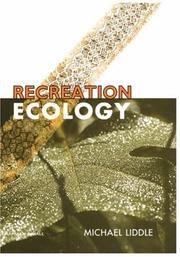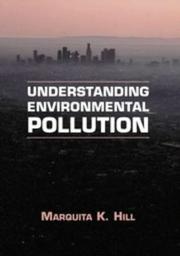| Listing 1 - 10 of 15 | << page >> |
Sort by
|
Book
ISBN: 9056070088 Year: 1997 Publisher: Brussel Society of Environmental Toxicology and Chemistry
Abstract | Keywords | Export | Availability | Bookmark
 Loading...
Loading...Choose an application
- Reference Manager
- EndNote
- RefWorks (Direct export to RefWorks)

Abstract | Keywords | Export | Availability | Bookmark
 Loading...
Loading...Choose an application
- Reference Manager
- EndNote
- RefWorks (Direct export to RefWorks)
Agrotechnology and Food Sciences. Toxicology --- Environmental chemistry --- Environmental toxicology --- QSAR (Biochemistry) --- Environmental Toxicology, Ecotoxicology --- Methodology --- Congresses. --- Environmental Toxicology, Ecotoxicology. --- Quantitative structure-activity relationships (Biochemistry) --- Structure-activity relationships (Biochemistry) --- Ecotoxicology --- Pollutants --- Pollution --- Environmental health --- Toxicology --- Chemistry, Environmental --- Chemistry --- Ecology --- Methodology&delete& --- Congresses

ISBN: 1281035246 9786611035242 008053385X 088415386X 9780080533858 9780884153863 9781281035240 6611035249 Year: 1997 Publisher: Houston, Tex. Gulf Pub.
Abstract | Keywords | Export | Availability | Bookmark
 Loading...
Loading...Choose an application
- Reference Manager
- EndNote
- RefWorks (Direct export to RefWorks)
This addition to the Advances in Environmental Control Technology Series contains 23 chapters designed to provide an extensive overview and reference on human physiological responses to various forms of pollution.
Environmental toxicology. --- Environmental health. --- Environmental quality --- Health --- Health ecology --- Public health --- Environmental engineering --- Health risk assessment --- Ecotoxicology --- Pollutants --- Pollution --- Environmental health --- Toxicology --- Health aspects --- Environmental aspects

ISBN: 1566701341 Year: 1997 Publisher: Boca Raton (Fla.) : CRC press,
Abstract | Keywords | Export | Availability | Bookmark
 Loading...
Loading...Choose an application
- Reference Manager
- EndNote
- RefWorks (Direct export to RefWorks)
Agrotechnology and Food Sciences. Toxicology --- Environmental Sciences and Forestry. Environmental Management --- Pesticides --- Pollution --- Soil ecology. --- Soil pollution. --- Toxicity testing. --- Environmental Toxicology, Ecotoxicology. --- Environmental Pollution --- Soil Pollution. --- Environmental aspects. --- Environmental aspects.
Book
ISBN: 2738006884 9782738006882 Year: 1997 Publisher: Paris : Institut National de la Recherche Agronomique (INRA),
Abstract | Keywords | Export | Availability | Bookmark
 Loading...
Loading...Choose an application
- Reference Manager
- EndNote
- RefWorks (Direct export to RefWorks)
Pollution --- Toxicité --- toxicity --- Impact sur l'environnement --- Environmental impact --- Risque --- risk --- Biodiversité --- Biodiversity --- Protection de l'environnement --- environmental protection --- Réglementation --- Regulations --- Prise de décision --- Decision making --- Participation sociale --- Social participation --- Environnement socioculturel --- sociocultural environment --- Continuing education --- 504.05 --- 502.55 --- Unfavourable influences of human activities on the environment. Ecotoxicology --- Pollution, contamination danger. Protection against pollution --- 502.55 Pollution, contamination danger. Protection against pollution --- 504.05 Unfavourable influences of human activities on the environment. Ecotoxicology --- Ecology. --- Environmental monitoring. --- Pollution. --- Risk assessment --- Toxicology

ISBN: 041226630X Year: 1997 Publisher: London Chapman and Hall
Abstract | Keywords | Export | Availability | Bookmark
 Loading...
Loading...Choose an application
- Reference Manager
- EndNote
- RefWorks (Direct export to RefWorks)
379.84 --- 379.85 --- 504.05 --- 574 --- 57.048 --- Openluchtrecreatie. Outdoor recreation --- Vrijetijdsreizen. Toerisme --- Unfavourable influences of human activities on the environment. Ecotoxicology --- General ecology. Biocoenology. Hydrobiology. Biogeography --- Social factors. --- ECO Ecology --- community ecology --- ecology --- ecotourism --- fauna --- handbooks --- recovery --- recreation ecology --- resistance --- survival --- 57.048 Social factors. --- 574 General ecology. Biocoenology. Hydrobiology. Biogeography --- 504.05 Unfavourable influences of human activities on the environment. Ecotoxicology --- 379.85 Vrijetijdsreizen. Toerisme --- 379.84 Openluchtrecreatie. Outdoor recreation
Book
ISBN: 9002206410 Year: 1997 Publisher: Antwerpen Icarus
Abstract | Keywords | Export | Availability | Bookmark
 Loading...
Loading...Choose an application
- Reference Manager
- EndNote
- RefWorks (Direct export to RefWorks)
Sociology of environment --- Criminology. Victimology --- Flanders --- Environnement --- Flandre --- Gezondheidszorg --- Milieu --- Milieuverontreiniging --- Pollution de l'environnement --- Soins de santé --- Vlaanderen --- 614.7 --- 502.55 --- 504.05 --- 504 <493-17> --- 351.777 --- #A9710A --- 614.62 --- Milieuproblemen --- Pollutie van lucht, water, grond--(openbare gezondheidszorg) --- Pollution, contamination danger. Protection against pollution --- Unfavourable influences of human activities on the environment. Ecotoxicology --- Environment. Environmental science--Vlaanderen. Vlaams Gewest. Nederlandstalige Gemeenschap in België --- Bodemverontreiniging --- 504 <493-17> Environment. Environmental science--Vlaanderen. Vlaams Gewest. Nederlandstalige Gemeenschap in België --- 504.05 Unfavourable influences of human activities on the environment. Ecotoxicology --- 502.55 Pollution, contamination danger. Protection against pollution --- C5 --- milieuvervuiling --- Maatschappelijke organisaties en maatschappelijk leven --- 570 --- milieu --- environnement

ISBN: 0521566800 0521562104 Year: 1997 Publisher: Cambridge : Cambridge University Press,
Abstract | Keywords | Export | Availability | Bookmark
 Loading...
Loading...Choose an application
- Reference Manager
- EndNote
- RefWorks (Direct export to RefWorks)
Leefmilieu --- 502.55 --- 504.05 --- 614.7 --- #WAAR:didaktiek --- Environnement --- Pollution, contamination danger. Protection against pollution --- Unfavourable influences of human activities on the environment. Ecotoxicology --- Pollutie van lucht, water, grond--(openbare gezondheidszorg) --- 504.05 Unfavourable influences of human activities on the environment. Ecotoxicology --- 502.55 Pollution, contamination danger. Protection against pollution --- Pollutants --- Pollution --- Chemical pollution --- Chemicals --- Contamination of environment --- Environmental pollution --- Contamination (Technology) --- Asbestos abatement --- Bioremediation --- Environmental engineering --- Environmental quality --- Factory and trade waste --- Hazardous waste site remediation --- Hazardous wastes --- In situ remediation --- Lead abatement --- Refuse and refuse disposal --- Chemical pollutants --- Contaminants, Environmental --- Environmental contaminants --- Environmental pollutants --- Environmental aspects --- Environmental policy. --- Pollution. --- Risk assessment --- Toxicology

ISBN: 0750638109 9780750638104 Year: 1997 Publisher: Oxford Butterworth-Heinemann
Abstract | Keywords | Export | Availability | Bookmark
 Loading...
Loading...Choose an application
- Reference Manager
- EndNote
- RefWorks (Direct export to RefWorks)
Environmental toxicology --- Health risk assessment --- ABB9809-IVB --- 12.01 --- Assessment, Health risk --- Health hazard appraisal --- Health hazard assessment --- Health risk appraisal --- HRA (Public health) --- Human risk assessment --- Medicine, Preventive --- Public health --- Risk assessment --- Environmental health --- Ecotoxicology --- Pollutants --- Pollution --- Toxicology --- Preventie ; Algemeen

ISBN: 0412098512 1461377501 1461560039 Year: 1997 Publisher: New York Chapmann & Hall
Abstract | Keywords | Export | Availability | Bookmark
 Loading...
Loading...Choose an application
- Reference Manager
- EndNote
- RefWorks (Direct export to RefWorks)
From its inception, the U.S. Department of the Interior has been charged with a conflicting mission. One set of statutes demands that the department must develop America's lands, that it get our trees, water, oil, and minerals out into the marketplace. Yet an opposing set of laws orders us to conserve these same resources, to preserve them for the long term and to consider the noncommodity values of our public landscape. That dichotomy, between rapid exploitation and long-term protection, demands what I see as the most significant policy departure of my tenure in office: the use of science-interdisciplinary science-as the primary basis for land management decisions. For more than a century, that has not been the case. Instead, we have managed this dichotomy by compartmentalizing the American landscape. Congress and my predecessors handled resource conflicts by drawing enclosures: "We'll create a national park here," they said, "and we'll put a wildlife refuge over there." Simple enough, as far as protection goes. And outside those protected areas, the message was equally simplistic: "Y'all come and get it. Have at it." The nature and the pace of the resource extraction was not at issue; if you could find it, it was yours.
Nature protection --- General ecology and biosociology --- Environmental protection. Environmental technology --- Ressource naturelle --- Natural resources --- Conservation des ressources --- Resource conservation --- Animal sauvage --- wild animals --- Plante sauvage --- Wild plants --- Modèle --- Models --- Biodiversité --- Biodiversity --- Succession écologique --- ecological succession --- Écosystème --- ecosystems --- Conservation biology --- -Ecology --- -502.35 --- Balance of nature --- Biology --- Bionomics --- Ecological processes --- Ecological science --- Ecological sciences --- Environment --- Environmental biology --- Oecology --- Environmental sciences --- Population biology --- Ecology --- Nature conservation --- Congresses --- Conservation management in general. Monitoring --- 502.35 Conservation management in general. Monitoring --- 502.35 --- Ecology . --- Nature conservation. --- Plant physiology. --- Ecotoxicology. --- Ecology. --- Nature Conservation. --- Plant Physiology. --- Ecotoxicology --- Pollutants --- Pollution --- Environmental health --- Toxicology --- Botany --- Plants --- Physiology --- Conservation of nature --- Nature --- Protection of nature --- Conservation of natural resources --- Applied ecology --- Endangered ecosystems --- Natural areas --- Conservation
| Listing 1 - 10 of 15 | << page >> |
Sort by
|

 Search
Search Feedback
Feedback About UniCat
About UniCat  Help
Help News
News